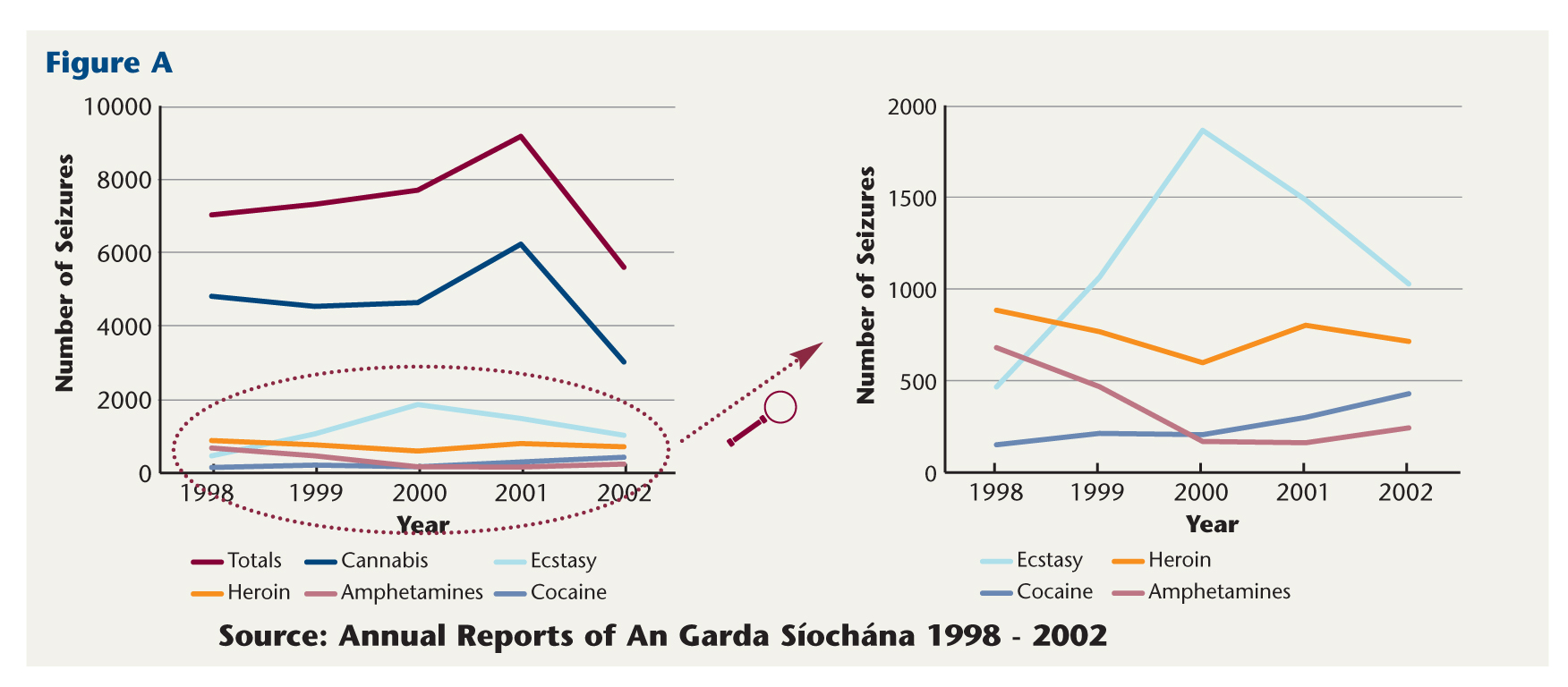Connolly, Johnny (2004) Drug seizures down by thirty-nine per cent. Drugnet Ireland, Issue 10, March 2004, pp. 3-4.
| Preview | Title | Contact |
|---|---|---|
|
PDF (Drugnet Ireland, issue 10)
- Published Version
287kB |
Drug seizures down by thirty-nine per cent
The Annual Report of An Garda Síochána for 2002 was published in January 2004. The report is the main source of information on crime in Ireland. It includes information on crimes reported to and recorded by An Garda Síochána and in which criminal proceedings are taken. The report includes a specific chapter on drug offences. This details information such as the number of drug offences in which proceedings were taken, by police division and drug type, particulars of drugs seized, the number, age and gender of persons charged as well as the nature of the offence.
Figure A looks at drug seizure trends for a selection of drugs between 1998 and 2002. We can see that there was a 39 per cent drop in the total number of drug seizures in 2002, down from a total of 9169 seizures in 2001 to 5603 seizures in 2002. This drop appears to have been caused by a 51 percent decrease in cannabis seizures and a 31 per cent drop in seizures of ecstasy. One of the key performance indicators under the supply reduction pillar of the National Drugs Strategy 2001 – 2008 is to ‘Increase the volume of opiates and all other drugs seized by 25% by end 2004 and by 50% by end 2008 (using 2000 seizures as a base) 1

Figure A also shows, however, that over the same period, cocaine seizures have increased by 55 percent, from a total of 151 seizures in 1998 to 429 seizures in 2002. Amphetamine seizures also increased during 2002.
The Annual Report 2002 is the first year when the full impact of the new Garda information technology system PULSE (Police Using Leading Systems Effectively) is seen in the statistics. For example, tables are presented outlining outcomes not only for what the Gardaí describe as ‘headline’ drug offences, but also more information is provided than heretofore regarding ‘non-headline’ drug offences. These terms are generally used to distinguish serious from less serious offences. As most drug offences fall into the ‘non-headline’ category and are dealt with summarily in the district court, the new format enhances the overall picture as to how drug offences are prosecuted in the courts.
In 2002, the total number of drug offences in which criminal proceedings commenced was 7,976. Three-quarters of these (75%) were for simple possession 2 while one in four (19%) were for drug dealing. 3 Of the ‘Headline’ drug offences in which criminal proceedings commenced (N=1800), approximately 15 percent led to a conviction on indictment (i.e before a jury). Of the 6,176 ‘Non-headline’ drug offences in which criminal proceedings commenced, just over 32 percent led to a conviction.
The report also provides information on drug offences where proceedings commenced, by drug type. In 2002, approximately 65 per cent of drug offences where proceedings commenced were cannabis-related, 10 per cent were heroin-related and approximately 5 percent related to cocaine. Figure B shows trends in offences where proceedings commenced by drug category between 1998 and 2002. We can see a steady increase in cannabis-related prosecutions since 1998 and a decline in ecstasy-related prosecutions since 2000. Heroin-related prosecutions appear to have fluctuated from year to year, while cocaine-related prosecutions increased in 2002.
Figure B - Please see PDF copy
Source: Annual Report of An Garda Síochána 1998 - 2002
Despite recent improvements in the Annual Report, a number of shortcomings in the compilation and presentation of official crime statistics have been identified. 4 Such problems are not confined to the Garda statistics alone but cut across the criminal justice system in general. The statistics are silent on the number of drug arrests which take place; we cannot track the course of prosecutions through the system or identify the nature of sentences passed. Action Four of the National Drugs Strategy identifies this as an issue requiring attention during the lifetime of the strategy. It is one of the matters currently being investigated by the Expert Group on Crime Statistics, which is due to report to the Minister for Justice, Equality and Law reform later this year.
1. Government of Ireland (2001) Building on Experience: National Drugs Strategy 2001 – 2008 p109.
2. Section 15 Misuse of Drugs Act, 1977.
3. Section 15 Misuse of Drugs Act, 1977.
4. For a recent consideration of this issue see Dr Ian O’Donnell ‘Flawed Garda figures fail to give insight into crime’ Irish Times 3rd Febuary 2003.
Repository Staff Only: item control page